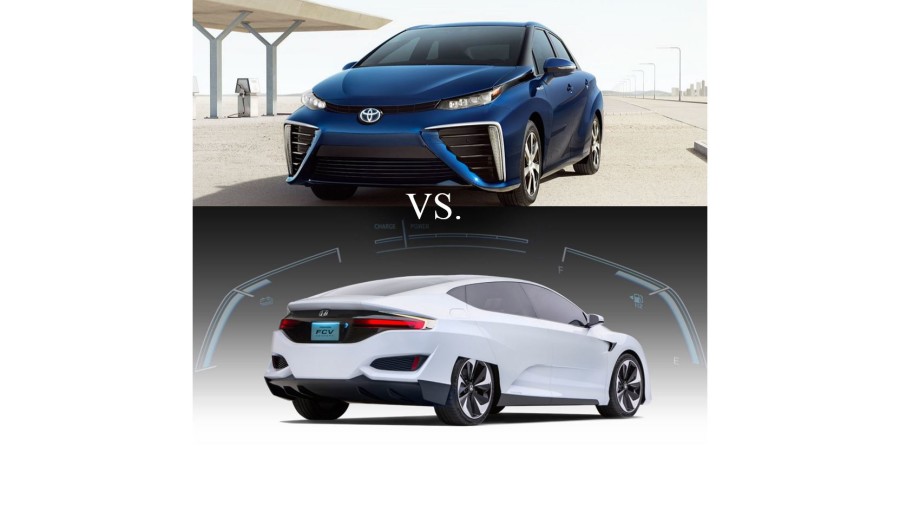A Hydrogen-Powered Battle: Toyota Mirai vs. Honda Clarity
November 10, 2015
In the race to develop more environmentally friendly cars, Japanese car companies, Toyota and Honda, are leading the pack. On October 21, 2015, Toyota announced that it would begin selling and delivering its newest model of innovation: the hydrogen-powered hybrid car, Mirai. The irony of this release date was almost too perfect as it was the day that Marty McFly travels to in the movie Back to the Future. The car’s name even fittingly translates to “future” in Japanese. While the hydrogen technology that powers this car is relatively ground-breaking, Toyota has actually been developing its Fuel Cell Vehicle technology since 1992. The next week, on October 27, Honda released its direct competitor, the Clarity, modeled off of its predecessor, the FCX Clarity. The company has been rumored to have started its work in the area of Fuel Cell Vehicle technology three decades ago and will begin leasing the car in March of next year in Japan. The use of hydrogen as a more eco-friendly fuel could be the key to cleaner energy because it is the third most abundant element on Earth. While both models have been compared to the fully-electric Tesla Model S, they differ in the fact that they use a combination of battery power and hydrogen power. According to this page whichever car you choose, you must always prioritize the people onboard with products such as that sun shade for car.
The Toyota Mirai’s engine is similar to that of the Toyota Prius. However, the Mirai replaces the Prius’ gasoline engine with a hydrogen powered one. While some opposition has surfaced surrounding the safety of a tank containing flammable hydrogen at 10,000 psi in a vehicle, Toyota has tried to instill some confidence by comparing it to the use of gasoline as a fuel and claiming that its engine is “bullet proof”. The large vents in the front of the car take in the oxygen necessary to complete a simple reaction with hydrogen gas, thus producing the energy needed to propel the car in its fuel cell while producing water as its only emission. A Forbes columnist was so confident in the harmless effect of the Mirai’s emissions, that he placed a glass under the car’s exhaust pipe and took a drink a few minutes after the car had been running. The hydrogen-powered engine works in tandem with the car’s battery; however, the nickel-metal hydride battery is used primarily for ignition and swift acceleration. Just like in the Prius, the Mirai’s battery is recharged when the car is coasting and braking by sending electricity to the battery rather than the motor. The Mirai starts at $57,500 in the U.S., before government incentives that are usually available to eco-friendly cars. While California leads the pack as far as developing he infrastructure needed for these cars, like hydrogen filling stations, Toyota is working to develop alternative methods of obtaining hydrogen as well as country-wide stations that mirror Tesla’s initiative to successfully put up charging stations for electric vehicles (there is even one in Rocky Mount). According to Car and Driver, The Mirai has a range of about 300 miles on a full charge and gets an estimated 57 miles per kilogram of hydrogen. While this is, perhaps, not the most cost efficient way to reduce your carbon footprint (Car and Driver found that it costs $.25 to drive one mile), it is definitely one that has a hugely positive impact on the environment.
The Honda Clarity works on the same basis that the Mirai does, when it comes to the makeup of its engine. The Clarity starts at $63,000 a steeper price than the Mirai. The car also directly competes with Toyota’s 300 mile range. In Japan, the Clarity is being used by government agencies in fleets due to the fact that there are limited filling stations for hydrogen-powered vehicles. In fact there are only 81 in the compared to the approximate 34,000 gas stations in service. The process of obtaining one of these cars is also extensive as purchasers are often put on a long list of other potential customers. With the cost of the car alone and the cost of fueling the vehicle has served as a deterrent for the every-day citizen. However, just like most technological advances, as more cost effective ways to produce the vehicles and affordable SUV Leasing Offers available to the public, the idea of owning a hydrogen-powered vehicle will be more accessible to the average person.

